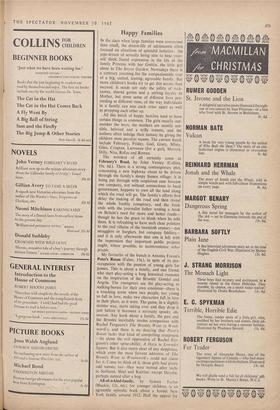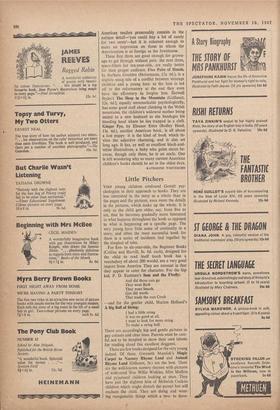Happy Families
All this batch of happy families tend to have certain things in common. The girls usually out- number the boys; the mothers are usually sen- sible, beloved and a trifle remote; and, the authors often indulge their fantasy by giving the children most peculiar names. The current batch include February, Friday, Gail, Ginty, Minty, Giles, Crispian, Lawrence (for a girl), Mervyn, Dilly, Nita, Rufus and Rowan.
The weirdest of all certainly come in February's Road, by John Verney (Collins, 10s. 6d.). There is a strong contemporary plot, concerning a new highway about to be driven through the family's sleepy Sussex village; it is being put through with suspicious ease because one company, not without connections in local government, happens to own all the land along which the road will go. The family's efforts first delay the making of the road, and then reveal the whole loathly conspiracy, and the book ends with the journalist father writing a book on Britain's need for more and better roads— though he has the grace to blush when he tells them. It is refreshing to have such clear pointers to the real villains of the twentieth century—not smugglers or burglars, but company fiddlers— and it is only afterwards that one is left with the impression that important public projects ought, where possible, to inconvenience other people.
My favourite of the bunch is Antonia Forest's Peter's Room (Faber, 15s.), in spite of its pre- occupation with the passion of young girls for ponies. This is about a family, and one friend, who start play-acting a long historical romance on the inspiration of the Brontes' Gonda' and Angria. The youngsters use the play-acting as stalking-horses for their own emotions—there is a touching scene when two people, too young to fall in love, make two characters fall in love in their place, as it were. The game, in a slightly sinister way, starts taking over and they drop it just before it becomes a seriously spooky ob- session. Any book about a family, the past and the Brontes inevitably invites comparison with Rachel Ferguson's The Brontes Went to Wool- worth's, and there is no denying that Peter's Room lacks' that kind of compelling creepiness —let alone the evil oppression of Rachel Fer- guson's other spine-chiller, A Harp in Lowndes Square. But it also steers clear of any sloppiness, which even the most fervent admirers of The Brontës Went to Woolworth's could not claim for it. Come to think of it, those girls had pretty odd names, too—they were named after lochs in Scotland, Shiel and Katrine; except Deirdre, perhaps named after a bog.
All-of-a-kind-family, by Sydney Taylor (Blackie, 12s. 6d.), for younger children, is an agreeable episodic book about a Jewish New York family around 1912. Half the appeal for American readers presumably consists in the antique detail—`you could buy a lot of candy for two cents'—but it is coherent enough to make an impression on those to whom the Americanism is as foreign as the Jewishness.
These first three are good enough for grown- ups to get through without pain: the next three, space-fillers for ten-year-olds, are really better for their proper audience. Five Pairs of Hands, bs Barbara Goolden (Heinemann, 12s. 6d.), is a slightly smug tale of a conflict between vicarage children and a young lout: as the lout is led off to the reformatory at the end they even have the effrontery to forgive him. Showell Styles's The Shop in the Mountain (Gollancz, 12s. 6d.), equally unremarkable psychologically, has some good stuff about climbing in the Welsh mountains, the children's widowed mother being united to a new husband as she bandages his bleeding head where he lies trapped in a cleft. Ginger Pye, by Eleanor Estes (Bodley Head, 13s. 6d.), another American book, is all about a lost puppy' it is the kind of book which in- vites the adjective charming, and is also set long ago. It has, as well as excellent black-and- white illustrations, a baby who gains status be- cause, though only three, he is an uncle. One is left wondering why so many current American children's books should be set in the olden days.
KATHARINE WHITEHORN











































 Previous page
Previous page